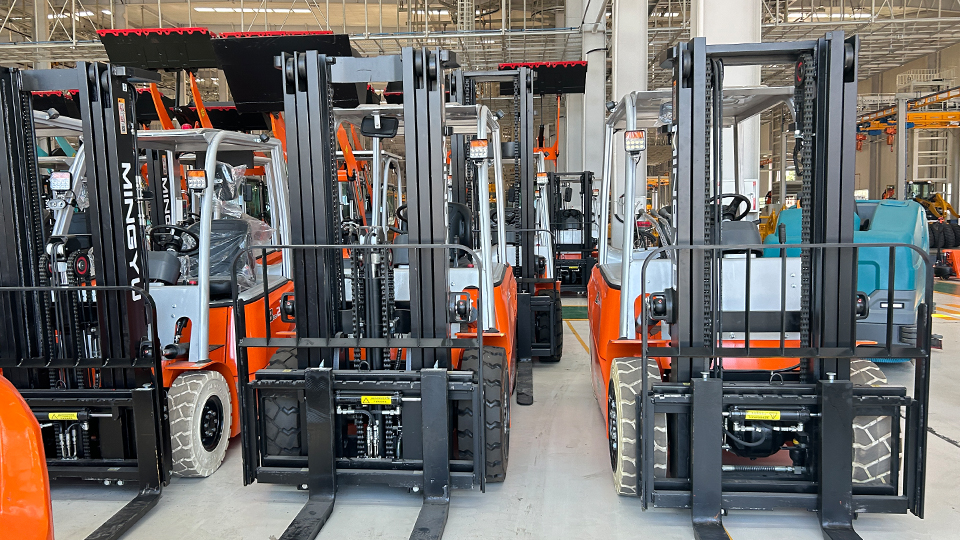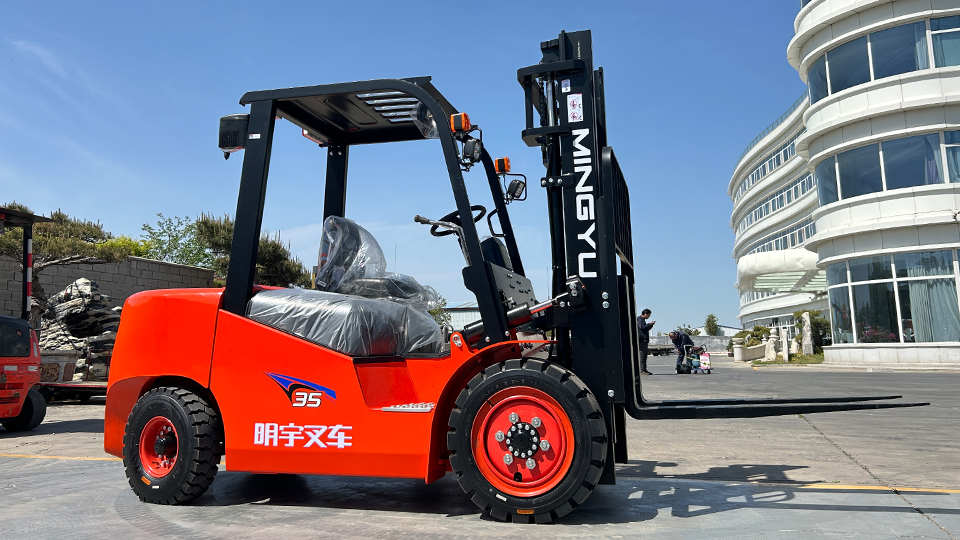
Operating a forklift is a skilled task that demands precision, awareness, and a thorough understanding of safety protocols. To ensure these critical capabilities, proper training is not just recommended, but mandated by regulatory bodies like the Occupational Safety and Health Administration (OSHA) in the United States, and similar organizations globally. A common question among individuals and businesses considering forklift operation is: "How long is a forklift training course?" The answer, however, is not a simple fixed number of hours. It's a nuanced response influenced by various factors, including the type of training, the operator's prior experience, the specific forklift class, and the training provider. This comprehensive technical article will delve into the components of forklift training, typical course durations, regulatory requirements, and what to expect during the certification process.
The Regulatory Framework: OSHA and Beyond
The cornerstone of forklift training requirements in the United States is OSHA Standard 29 CFR 1910.178 (Powered Industrial Trucks). This standard unequivocally states that only "trained and authorized" operators are permitted to operate a powered industrial truck. While OSHA does not specify an exact number of hours for training, it outlines the content and structure of the training program. This performance-based approach emphasizes competency rather than mere time spent.
Key OSHA requirements include:
Formal Instruction: This can include lectures, discussions, interactive computer learning, videos, and written materials. It covers theoretical knowledge such as forklift stability, controls, pre-operational checks, specific operating instructions, and workplace hazards.

Practical Training: This involves hands-on demonstrations performed by the trainer and practical exercises performed by the trainee. This segment focuses on developing the physical skills required to operate the forklift safely and efficiently.
Evaluation of Performance: The operator's performance must be evaluated in the workplace. This ensures that the trainee has acquired the necessary skills and can operate the forklift safely under actual working conditions.
Similar regulatory bodies exist internationally, such as the Health and Safety Executive (HSE) in the UK, WorkSafeBC in British Columbia, Canada, and various national labor departments. While specific regulations may vary, the core principles of formal instruction, practical application, and performance evaluation remain consistent across most developed nations.
Components of a Comprehensive Forklift Training Course
Regardless of the duration, a high-quality forklift training course will encompass several essential components designed to impart both theoretical knowledge and practical skills.
1. Formal Instruction (Classroom/Online)
This initial phase focuses on the theoretical aspects of forklift operation and safety. Topics typically covered include:
Introduction to Forklifts: Different types of forklifts (Class I-VII), their components, and their applications.
OSHA/Regulatory Requirements: A detailed review of applicable safety regulations and standards.
Forklift Stability Principles: Understanding the center of gravity, load capacity, stability triangle, and factors affecting stability. This is a critical component for preventing tip-overs.
Pre-Operational Inspections: How to conduct thorough daily checks of the forklift's components, including tires, brakes, fluid levels, lights, horn, and safety devices.
Controls and Instrumentation: Familiarization with the specific controls, gauges, and warning indicators of the forklift being trained on.
Safe Operating Procedures: General rules for safe operation, including speed limits, pedestrian safety, maneuvering in tight spaces, blind spots, and avoiding hazards.
Load Handling Techniques: Proper lifting, lowering, stacking, and unstacking procedures, including understanding load centers and weight distribution.
Workplace Hazards: Identification and mitigation of common workplace hazards such as ramps, aisles, overhead obstructions, dock areas, and hazardous materials.
Battery/Fuel Handling: Safe procedures for refueling (propane, gasoline, diesel) or recharging batteries.
Attachments: Safe use and limitations of various forklift attachments (if applicable).
Emergency Procedures: What to do in case of an accident, tip-over, or equipment malfunction.
2. Practical Training (Hands-on)
This is where trainees translate theoretical knowledge into practical skills. Under the direct supervision of a qualified instructor, trainees will:
Conduct Pre-Operational Checks: Perform hands-on inspections of the forklift.
Familiarize with Controls: Practice operating the various controls in a safe, controlled environment.
Basic Maneuvering: Drive the forklift forward and backward in open spaces, focusing on smooth starts and stops.
Steering and Turning: Practice making turns in both directions, understanding the unique steering characteristics of forklifts.
Load Pickup and Placement: Practice picking up and placing loads at various heights and in different configurations (e.g., stacking, de-stacking).
Operating on Ramps/Inclines: Practice ascending and descending ramps with and without loads.
Negotiating Obstacles: Maneuver the forklift around cones or other simulated obstacles.
Parking and Shut Down: Safely park the forklift and follow proper shut-down procedures.
Propane Tank Exchange/Battery Charging: Practice safe procedures for fuel or battery handling.
3. Evaluation of Performance
The final and crucial step is the formal evaluation. This involves:
Written Examination: To assess understanding of the theoretical concepts covered in formal instruction.
Practical Driving Test: The instructor observes the trainee operating the forklift in a simulated or actual work environment, assessing their ability to safely perform tasks and adhere to learned procedures. This is where the "performance-based" aspect of OSHA comes into play. The operator must demonstrate proficiency.

Factors Influencing Course Length
The duration of a forklift training course is highly variable and depends on several key factors:
1. Operator's Prior Experience
New/Novice Operators: Individuals with no prior forklift experience will require the most extensive training. This typically involves more hours of both formal instruction and hands-on practice to build foundational skills and confidence.
Experienced Operators (Refresher Training): Operators who have previously been certified but require recertification (usually every three years as per OSHA) or who are experienced but new to a specific type of forklift may require less time. Refresher courses primarily focus on reviewing safety principles, addressing any bad habits, and familiarizing with new equipment or workplace conditions.
2. Type of Forklift (Class I-VII)
OSHA categorizes forklifts into seven classes based on their power source and intended use. Training must be specific to the type of forklift an operator will be using.
Class I (Electric Motor Rider): Counterbalance forklifts, stand-up riders.
Class II (Electric Motor Narrow Aisle): Reach trucks, order pickers.
Class III (Electric Motor Hand or Hand-Rider): Pallet jacks, walkie stackers.
Class IV (Internal Combustion Engine - Solid/Cushion Tires): Typically used indoors on smooth surfaces.
Class V (Internal Combustion Engine - Pneumatic Tires): Used indoors or outdoors, on various surfaces.
Class VI (Electric & Internal Combustion Engine Tractors): Tow tractors.
Class VII (Rough Terrain Forklift Trucks): Used outdoors on uneven terrain.
Training for a basic Class V (internal combustion, pneumatic tire) counterbalance forklift might be quicker than for a specialized Class II narrow-aisle reach truck that requires more precise maneuvering skills and advanced control understanding. Operating multiple classes of forklifts will necessitate training specific to each class, extending the overall training time.
3. Training Provider and Format
On-Site Training: Many companies opt for on-site training conducted by a certified instructor at their facility. This allows for training on the specific equipment and in the actual work environment, which is highly beneficial. The duration can be tailored to the needs of the employees.
Off-Site Training Facilities: Specialized training centers offer courses that typically have a set schedule and curriculum. These might be general courses or specific to certain forklift classes.
Online/Blended Learning: Some providers offer online formal instruction components, which can be completed at the trainee's own pace, followed by in-person practical training and evaluation. While the online portion can be flexible, the practical component still requires dedicated time.
"Train-the-Trainer" Programs: These courses certify individuals within a company to become forklift instructors, allowing the company to conduct their own in-house training. These programs are typically longer and more intensive, covering instructional techniques in addition to forklift operation.
4. Class Size and Instructor-to-Student Ratio
Smaller class sizes generally allow for more individualized attention and hands-on practice, potentially leading to a more efficient training process. A lower instructor-to-student ratio can reduce the overall time needed for practical components.
5. Workplace Specifics and Hazards
OSHA requires that training covers "site-specific" hazards. If a workplace has unique challenges (e.g., extremely narrow aisles, ramps, unusual loads, hazardous materials), additional training time may be dedicated to addressing these specific scenarios.
Typical Course Durations
Given the variables, here are some general estimates for forklift training course lengths:
For New, Novice Operators (Initial Certification):
Classroom/Formal Instruction: This typically ranges from 4 to 8 hours, depending on the depth of coverage and the training provider. Some online modules might allow for self-paced learning over a longer period.
Practical Training & Evaluation: This can vary significantly but usually requires 4 to 12 hours of hands-on operation and assessment. This often includes guided practice, demonstrations, and the final practical test.
Total Initial Certification: For a new operator, expect a comprehensive course to last anywhere from 8 hours to 24 hours (1 to 3 full days), or even more for highly specialized equipment or extensive practical requirements. Many reputable programs aim for a minimum of 8-12 hours for basic counterbalance forklifts to ensure thorough understanding and skill development.
For Experienced Operators (Refresher/Recertification):
Refresher courses are generally shorter, focusing on reinforcing safety principles and addressing any changes in regulations or equipment.
Total Refresher Certification: These typically range from 4 to 8 hours, often combining a brief classroom review with practical evaluation. If an operator demonstrates significant unsafe habits, more extensive re-training may be required.
For Operators Certifying on Multiple Forklift Classes:
If an operator needs to be certified on, for example, both a sit-down counterbalance forklift (Class V) and a narrow-aisle reach truck (Class II), the training time will increase. While some foundational knowledge overlaps, each class requires specific practical training and evaluation due to differences in controls, stability, and operational characteristics. This could add several hours or even another full day of training per additional class.
What to Expect During the Training Process
Enrollment and Pre-requisites: Check for any age requirements (typically 18 years old) and sometimes basic literacy.
Theory Session: Expect a mix of lectures, videos, discussions, and potentially quizzes to ensure understanding of the safety principles.
Practical Demonstrations: The instructor will show proper techniques for operating the specific forklift.
Hands-on Practice: This is the most crucial part. You'll spend time in a controlled environment, operating the forklift under supervision. Mistakes are expected here – it's a learning environment.
Written Test: Usually a multiple-choice exam to test your knowledge of safety regulations and operational theory.
Practical Driving Test: You'll be asked to perform a series of maneuvers, including pre-operational checks, driving forward/backward, turning, lifting/lowering loads, and navigating obstacles. The instructor will evaluate your adherence to safety protocols and operational proficiency.
Certification: Upon successful completion of both the written and practical tests, you will receive a certificate of completion and/or a wallet card, signifying your authorization to operate the specific class(es) of forklifts.
Beyond the Initial Certification: Ongoing Training
Forklift training is not a one-time event. OSHA requires:
Refresher Training: At least once every three years.
Additional Training: When an operator is observed operating unsafely, is involved in an accident or near-miss, is assigned to operate a different type of forklift, or if there are changes in the workplace that could affect safe operation.
This ongoing training ensures that operators maintain their skills, stay updated on new regulations or equipment, and address any developing unsafe habits.
Conclusion
The question of "how long is a forklift training course" has no single answer. While an initial certification for a novice operator might typically range from 8 to 24 hours over one to three days, and refresher courses typically 4 to 8 hours, these are broad estimates. The actual duration is dictated by the operator's prior experience, the specific forklift class, the training provider's curriculum, and the unique demands of the workplace. What remains constant across all scenarios is the emphasis on competency and safety. Effective forklift training is an investment in safety, productivity, and compliance, ensuring that operators possess the knowledge and skills necessary to operate these powerful machines responsibly and efficiently. Employers and prospective operators should prioritize comprehensive training that meets or exceeds regulatory requirements, focusing on the quality of instruction and practical application rather than simply the clock time.
Name: selena
Mobile:+86-13176910558
Tel:+86-0535-2090977
Whatsapp:8613181602336
Email:vip@mingyuforklift.com
Add:Xiaqiu Town, Laizhou, Yantai City, Shandong Province, China